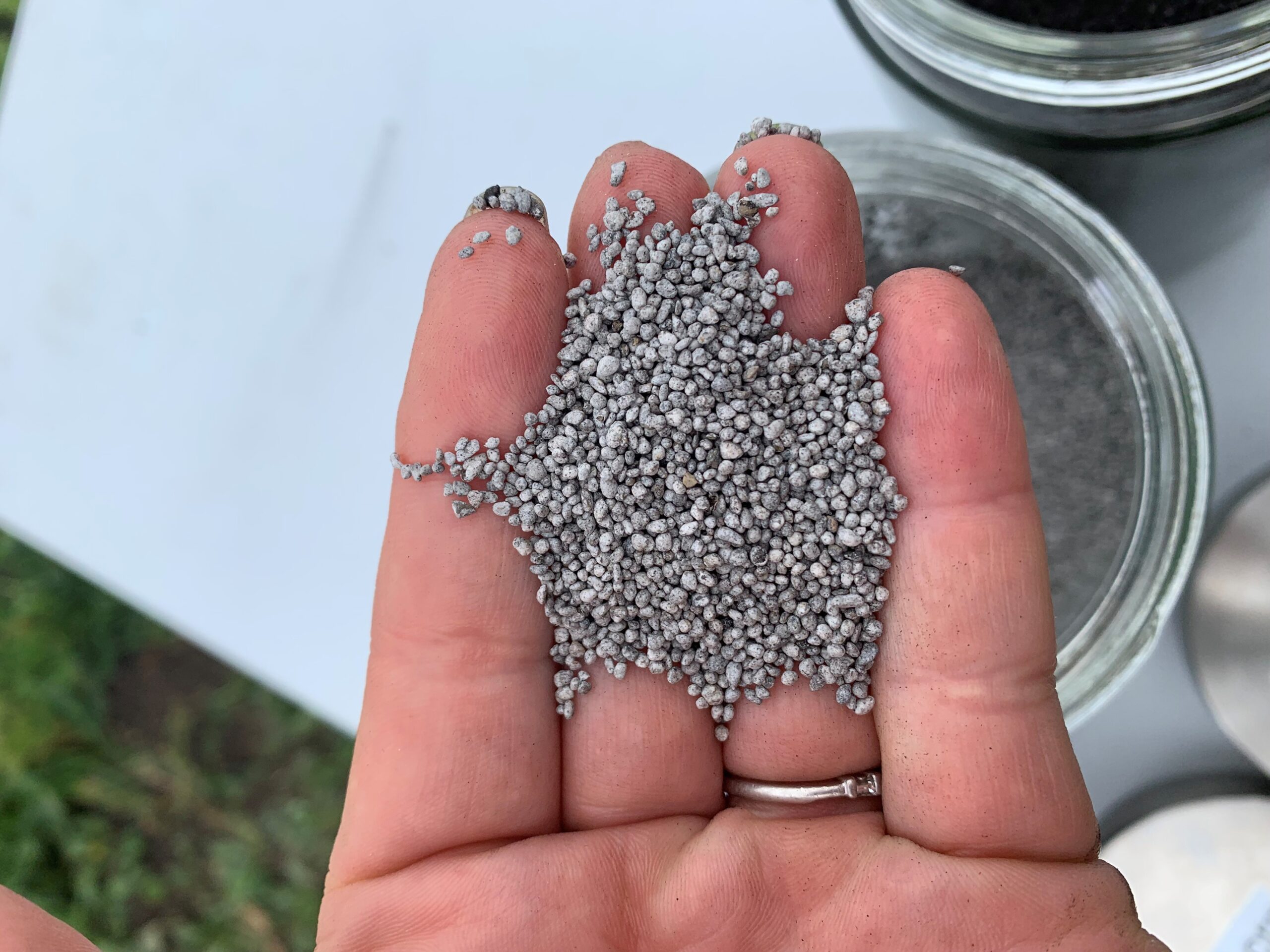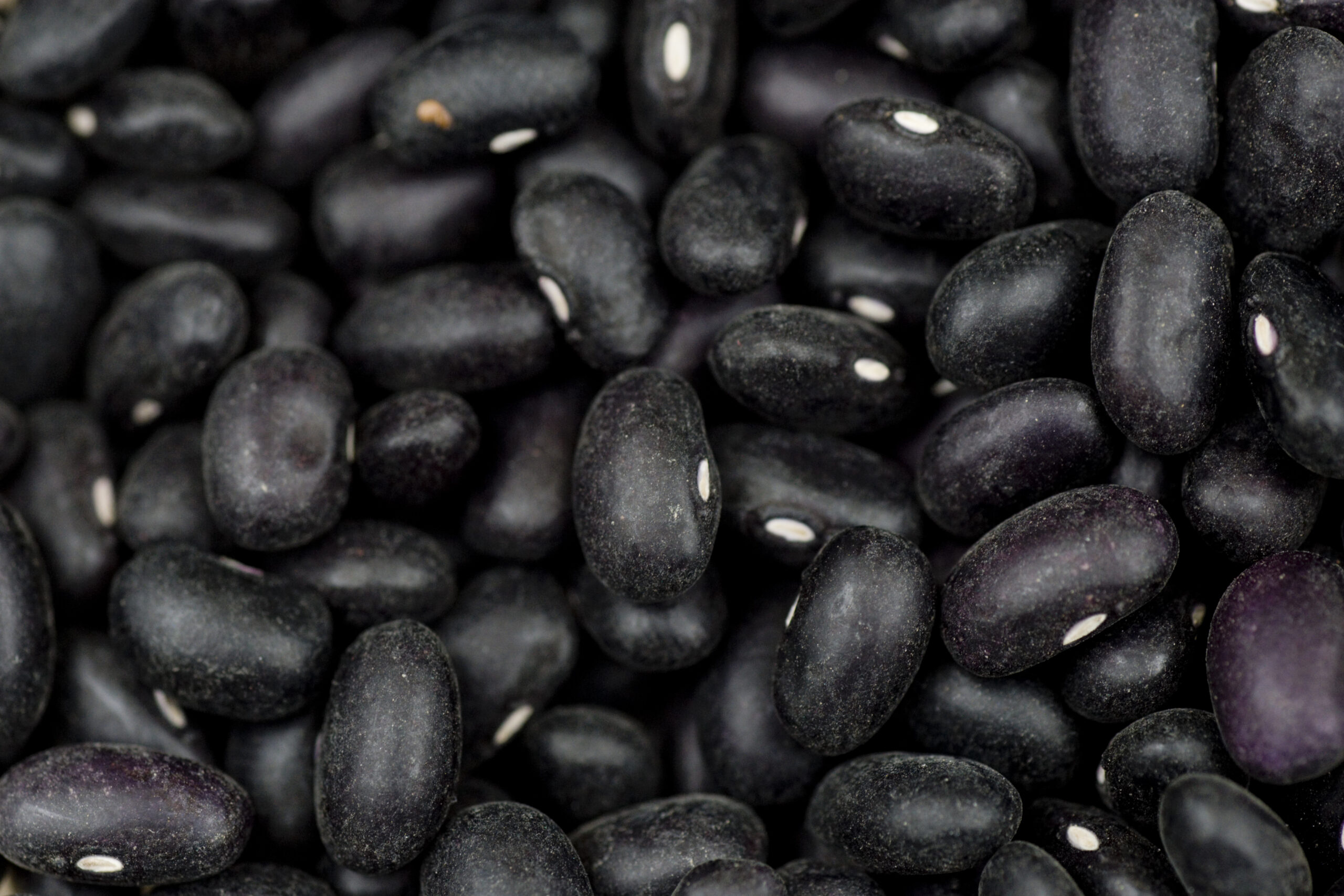Adapted from Dale Risula PAg., Provincial Special Crops Specialist (Saskatchewan Agriculture) and Bruce Barker, PAg
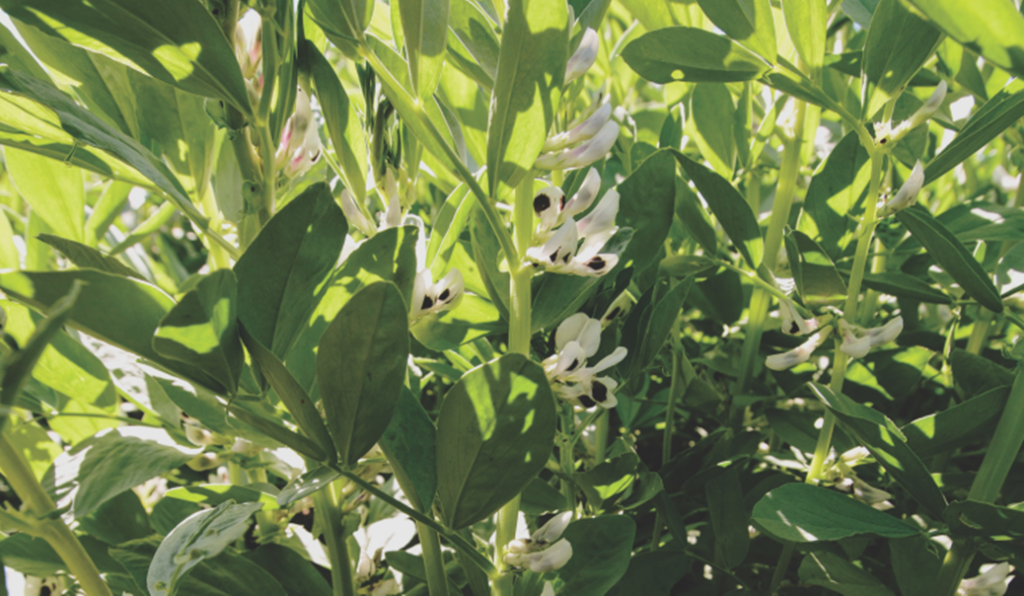
Accurate field measurements of nitrogen fixation responses to inoculation with Rhizobium are often difficult, undependable, and expensive. However, nitrogen fixation can be estimated through an assessment of nodulation and plant growth characteristics.
This guide will help growers and agronomists learn how to assess nodulation and nitrogen fixing potential in the field.
Nodule Assessment Timing
Nodulation assessments should be done during early flowering. Nodule formation begins approximately 14 days after crop emergence, but under certain conditions formation may take three to four weeks.
Nodule numbers and nitrogen fixation rates are generally at a maximum during early- to mid-flowering. After flowering, nodule efficiency is reduced and they begin to shut down.
Assessment Procedure
To assess the nodulation and nitrogen fixation potential of a pulse crop, select five areas that are typical of that field at early flowering. Follow the steps listed below in each of the five areas:
- Evaluate plant growth and vigour of the area according to the assessment codes shown in the following column.
- With a shovel, carefully dig up a minimum of two plants per area. Do not pull plants out of soil as nodules are delicately attached to roots and can be easily lost.
- Carefully examine plant roots to assess the nodules. Depending on the soil type and condition, this may require gently agitating the roots in water.
- Assess the overall nodulation by comparing the calculated scores to those provided for the three categories in the assessment guide.
Assessment Rating Scales
- Plant Growth and Vigour
Assess colour and overall health of the plant. Poor nitrogen fixation can cause nitrogen deficiency symptoms such as yellowing of the leaves at the base of the plant prior to flowering and poor plant development.
Plant Growth and Vigour Assessment Rating Scale
| Score | Description |
|---|---|
| 5 | Plants are green and vigorous |
| 3 | Plants are green, but relatively small |
| 2 | Plants are slightly chlorotic (yellow) |
| 1 | Plants are very chlorotic |
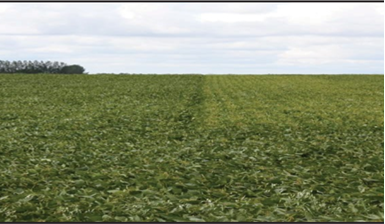
Source: Saskatchewan Ministry of Agriculture
- Colour and Abundance
Nitrogen fixation efficiency can be estimated with nodule color and the number of nodule clusters present. Carefully slice open the nodules. The strong pink color of the nodules is caused by the presence of leghaemoglobin, which must be present for active nitrogen fixation. If a nodule is brown, white, or green it is considered non-effective.
Colour and Abundance Assessment Rating Scale
| Score | Description |
|---|---|
| 5 | Greater than five clusters of pink pigmented nodules |
| 3 | Three to five clusters of mostly pink nodules |
| 1 | Less than three clusters of nodules OR white/green (unhealthy) nodules |
| 0 | No nodules OR white/green (unhealthy) nodules |

Source: Saskatchewan Ministry of Agriculture
- Nodule Position
Predominantly crown nodulation is observed when seed is inoculated. Lateral nodulation is prevalent when native rhizobia species exist in the soil or when granular inoculants are used. The crown region of a plant is generally the area of soil surrounding the seed. The approximate size of this region varies according to the crop.
Nodule Position Assessment Rating Scale
| Score | Description |
|---|---|
| 3 | Both crown and lateral nodulation |
| 2 | Mostly crown nodulation only |
| 1 | Mostly lateral nodulation only |

Source: Saskatchewan Ministry of Agriculture
- Total Score
Add up the scores from ratings of plant growth and vigour (1), colour and abundance of nodules (2), and nodule position (3) for a total score of overall nodulation (4).
Assessment Rating Scales Total Score
| Score | Description |
|---|---|
| 11 to 15 | Effective Nodulation |
| Numerous nodules that have good nitrogen fixing potential | |
| 7 to 10 | Nodulation Less Effective |
| Nodules present but with limited nitrogen fixing ptential | |
| 1 to 6 | Poor Nodulation |
| Few nodules present with very little to no nitrogen fixing potential |
In the field, a healthy plant does not always reflect effective nodulation and active nitrogen fixation. Localized soil environments, particularly with variations in soil nitrogen, may stimulate vigorous growth of the plant. Such situations are only apparent when the plants are excavated and examined for the presence of active nitrogen-fixing nodules.
Example Assessment Effective Nodulation
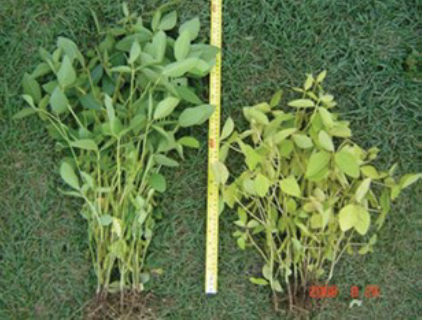
| Left Plants | Right Plants | ||
|---|---|---|---|
| Plant Growth/Vigour | 5 | Plant Growth/Vigour | 1 |
| Nodule Colour/Number | 3 | Nodule Colour/Number | 1 |
| Nodule Position | 3 | Nodule Position | 2 |
| Total Score | 11 | Total Score | 4 |
| Effective Nodulation | Poor Nodulation | ||
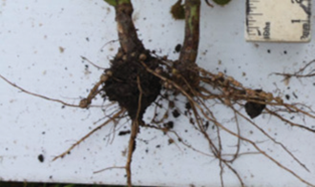
Source: Saskatchewan Ministry of Agriculture
Nodulating Rhizobia
Recently researchers found that inoculation rates higher than 105 cells/seed were usually required for high nodulation, nitrogen fixation, and grain yields. Therefore, Canadian standards, which require that 105 nodulating rhizobia be delivered per seed for large-seed legumes like peas, may need to be increased. They also found that coated seeds only provided benefits in acid soils, and provided little economic benefit compared to regular inoculant. Overall, population of rhizobia per seed is a critical factor. (Source: Rice et al, Evaluation of coated seeds as a Rhizobium delivery system for pea)
Response to Inoculant
In a recent study researchers found that, in faba bean, un-inoculated and inoculated plants nodulated equally well, suggesting the presence of adequate populations of effective indigenous Rhizobium leguminosarum bv. viciae for nodulation of untreated plants. The indigenous rhizobia could have originated from previous pea (Pisum sativum L.) crops or leguminous native plants/weeds. (Source: Ken J. Lopetinsky, et al, Contrasting Rhizobium inoculation requirements of zero-tannin faba bean and narrow-leafed lupin in Western Canada)
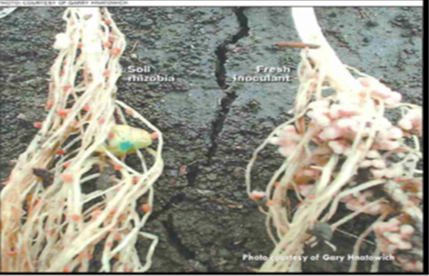
Source: Garry Hnatowich
Meanwhile, other studies have shown beneficial results by inoculating faba beans. So, by comparing the cost of nitrogen to inoculant, it pays to inoculate. Further evaluation is giving us a better understanding of faba bean’s response to granular and peat inoculants in various locations across Saskatchewan.
Research conducted in Alberta (McKenzie et al., 2006) and Saskatchewan (Gan et al., 2007) found that chickpea had favourable yield responses to rhizobial inoculant in absence of N fertilization. However, Gan et al. (2007) also found that application of nitrogen fertilizer, rather than inoculant, promoted an early pod set and accelerated crop maturity. Although insignificant differences were noted in dry years, nitrogen applied at 50lbs/ac without inoculant lead to earlier maturity by 13 days in normal and wet seasons.
Response of lentil to inoculant has varied across research conducted in Saskatchewan and Alberta. While there are studies that demonstated a positive yield response to inoculant, there have also been data that indicate yield was not impacted by inoculant. Despite these differences across studies, sites, and seasons, inoculation remains a recommended managed practice in lentil. Biological nitrogen fixation is very importance for agronomic and economic efficiency and there could be serious consequences to crop yield if a nodulation failure occurs.
Nodulation Failure
If nodulation does not occur, or is poor, it is possible to salvage the pulse crop. According to researchers from Manitoba who studied nodulation failure on soybeans, it is best to wait to the early pod fill stage and wait for early rainfall to get nitrogen into the rooting zone. In total, soybeans will generally remove 150-200 pounds per acre (lb/ac) of nitrogen to produce 30 bushels per acre (bu/ac) of crop. According to the Canadian Fertilizer Institute, on average peas remove 105-129 lb/ac of nitrogen to produce a 50 bu/ac crop. Lentils remove 55-67 lb/ac of nitrogen to produce a 30 bu/ac crop. Faba beans remove 154-188 lb/ac of nitrogen to produce a 50 bu/ac crop. Actual uptake and removal will vary with crop yield, crop variety, soil fertility, and from year to year. Accurate removal values can only be determined by laboratory analysis.
Soybean
In Saskatchewan, soybeans my suffer a nodulation failure because many fields are new to soybeans. The bacterium responsible for nodulation on soybeans is Bradyrhizobia japonicum, and it is not native in Saskatchewan soils.
Nodules take some time to form, with some nodules and nitrogen fixation starting around the vegetative (V2 to V3) stages. Nodulation should be assessed at the R1 stage of growth (beginning to bloom), and you should find healthy nodules on each plant. Results from a recent Manitoba Pulse and Soybean Growers study evaluating various inoculant products, rates, formulations, and combinations found that at least 10 nodules per plant were required to reach 90 per cent of maximum yield (Figure 8). If poor nodulation is suspected, a rescue application of nitrogen should be considered.
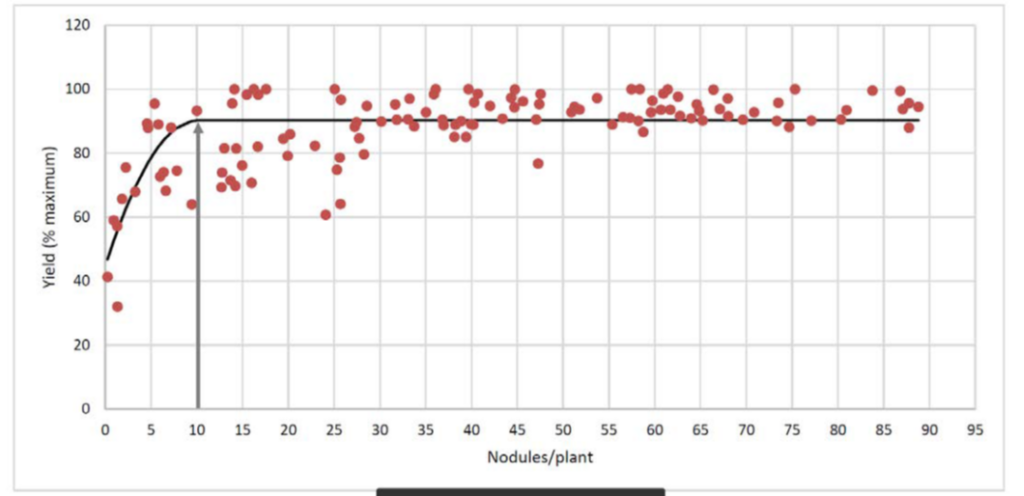
Source: Soybean Inoculant Strategies, Manitoba Pulse & Soybean Growers., Final Report, 2016
Research in Manitoba and Saskatchewan provides guidance on rates and timing of top dress application. In Manitoba in 2011, Manitoba Agriculture’s pulse specialist Dennis Lange conducted research on a virgin soybean field where the inoculant was mistakenly omitted. With 50 pounds of soil residual nitrogen per acre, the farmer broadcast-applied 100 pounds (lb) of nitrogen as urea seven days after seeding to bring up soil fertility to the 150 lb of nitrogen, targeting a 40 bushel soybean crop. Lange set up a trial on the same field and applied 50 or 100 lb of nitrogen as Agrotain-treated urea at early flower (R1) and pod fill (R4).
The farmer-applied treatment did not result in a yield increase compared to the check treatment with no additional fertilizer (Table 1). The additional nitrogen went to vegetative growth but not yield. The 50 and 100 lb applications at early flower (R1) did not produce a statistically significant yield increase over the control. However the application at the pod fill (R4) stage produced significantly higher yield, with an increase of eight to 10 bushels per acre, compared to the treatment with no added fertilizer.
Table 1. Yield and Quality Components for Soybeans With Application of Nitrogen Fertilizer
| Treatment | Yield (bu/ac) | Protein % | Nitrogen in Seed (lb N/ac) | Oil % | Seeds/lb |
|---|---|---|---|---|---|
| Check | 31.4 | 32.8 | 99 | 23.6 | 2,996 |
| 50 Nitrogen at Flowering | 33.7 | 33.8 | 109 | 23.2 | 2,989 |
| 50 Nitrogen at Pod Fill | 39.0 | 34.7 | 130 | 23.0 | 2,915 |
| 100 Nitrogen at Flowering | 33.6 | 36.5 | 118 | 22.2 | 2,792 |
| 100 Nitrogen at Pod Fill | 41.4 | 36.0 | 147 | 22.0 | 2,709 |
| 100 Nitrogen at Emergence | 31.5 |
In Saskatchewan, research led by Chris Holzapfel at the Indian Head Agriculture Research Foundation looked at nitrogen application rates, timing, and inoculation methods to develop nitrogen management recommendations for soybeans. The research was conducted over three years starting in 2015 at Indian Head, Melfort, and Outlook. Part of the research looked at a post-emergent, dribble-banded urea ammonium nitrate (UAN), applied at a rate of 50 lb of nitrogen per acre at the early pod (R3) stage. All treatments received a liquid seed inoculant, and four granular inoculant rates (0, 1x, 2x, and 4x) the label recommended rate of 4.5 kilograms per hectare (kg/ha).
In the absence of granular inoculant, nitrogen fertilization frequently (but not always) led to increased yields. However, yields were almost never increased to what was achieved with good nodulation and subsequent nitrogen fixation. While the responses were not always consistent, R3 applications of 50 lb of nitrogen were reasonably effective for mitigating yield loss. Averaged across eight sites, in-crop nitrogen applications recovered yield to approximately 88 per cent of the yields achieved with dual inoculation while, for comparison, yields with no rescue application were 75 per cent of the inoculated treatments.
Significant leaf burn was observed for UAN top dress applications. The researchers recommend a broadcast urea application for rescue treatments. Timing is best when rainfall is imminent. If rainfall is not forecast, a urease inhibitor may be warranted.
Pea and Lentil
A scenario was posed to pulse experts Dr. Bert Vandenberg with Crop Development Centre at the University of Saskatchewan, and Dr. Yantai Gan formerly with Agriculture and Agri-Food Canada at Swift Current regarding what to do if inoculant was not put down at seeding time or inoculant failure has occurred in pea or lentil. Both suggest that growers can apply 50 to 60 lb/ac of actual nitrogen as early as possible if nodulation failure has occurred or is expected, such as when inoculant application is absent or reduced.
In research carried out on peas in Montana in 1999 and 2000, fertilizer was applied after crop emergence to overcome nitrogen deficiency due to inoculant failure. Their conclusions indicated that yield loss due to inoculant failure could be prevented by applying fertilizer within six weeks of seeding, coinciding with the 9 to 12 node stage of pea.
The Saskatchewan Ministry of Agriculture recommends a top dress nitrogen application at a rate of 44 to 55 kg/ha (39 to 49 lb per acre).
If peas or lentils have been grown in the field previously there may be enough background rhizobia to induce nodulation. Under these conditions one can wait to see if nodulation occurs at early flowering. If no nodulation is apparent, then the grower should fertilize according to recommendations as soon as possible. More studies are required to better understand the response lentil and peas might have to variable time of application.
Chickpea
The previously described research in Montana conducted on pea was also initiated on chickpea. Yield could be preserved if fertilizer application was made to emerged chickpea by the 10 to 13 node stage.
Faba Bean
Research on rescue treatments for nodulation failure has not been conducted in faba bean. Although there is currently no recommendations available for this crop, faba bean has a very high demand for nitrogen so intervening with an early application of nitrogen fertilizer, similar to the suggested advice for pea and lentil crops, may be economical.
Dry Bean
While dry beans can fix a portion of their required nitrogen, the general recommendation is to apply higher levels of nitrogen in the soil, as dry beans tend to be poor nitrogen fixers. No information is available on top dressing nitrogen in dry beans grown in Saskatchewan; however, John Heard (University of Manitoba) examined nutrient partitioning in dry bean and found that the steepest part of the N uptake and biomass accumulation curve followed the R1 stage.
North Dakota State University recommends that, on irrigated dry bean, any additional nitrogen should be applied prior to vining and that all top dress nitrogen should be completed prior onset of pod filling.

